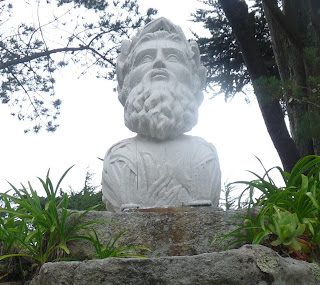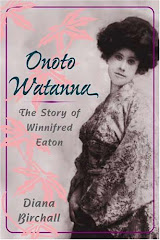Tresco Abbey
Quite a journey to get here! Woke up at the pretty Victorian hotel overlooking the harbor in Penzance, to a rainy day. Enjoyed an excellent English breakfast - poached egg, English bacon, "hogback" sausage, black pudding, haddock, beans, and brown toast, butter and honey - despite Jan pointing out that given the notorious choppiness of the crossing on the Scillonian, it might end up more out than in. We hauled our suitcases down the quay to the boat.
The Scillonian
"In the morning of Saturday, the twenty-seventh of March, 1852, I stood upon the old Quay, Penzance. In my place, a Roman would have abandoned the enterprise. The Iron Duke would have gone on." - Henry John Whitfeld
Approaching the Scilly Isles
The Scillonian is a big flat boat, and even though the crossing was somewhat rough, the rocking wasn't really enough to be a bother. The sun gleamed out once or twice, and we sat out on the deck, having a lovely restful time and talking of Jane Austen. However, when we arrived on St. Mary's, the largest of the Scilly islands, it started really raining hard. And the boat for Bryher which ought to have met us, couldn't come until 3:30, due to tides (it was then noon). Never mind, we left our bags, walked into the town, and had excellent hot potato leek soup, tea and a most frangible, delicious Victorian sponge cake at a nice tea shop, the Kavorna. Then we went to the museum, always fun to visit, one of my favorites with its extensive historical exhibits of the hundreds of shipwrecks in the history of the Scillies, plus quaint old displays of island life, birds and flowers. I bought some daffodil-and-narcissus post cards by a local artist and a first edition copy of What Katy Did Next for a pound.

Then we returned to the quay. The boat finally turned up at 4, in a heavy downpour. The small boat was way overcrowded with people, and knocked about a bit alarmingly, but the journey was short and we were on beautiful Bryher by 4:30. Surprisingly, nobody met us at the quay, but a pair of efficient retired schoolteacher ladies also going to the hotel called and got the truck to come, and so we were at the hotel in a trice. And oh, it is lovely - redecorated, posher than my last visit there (probably ten years ago), but still the beautiful, peaceful place I remembered. Jan’s room was a veritable two-storey suite, and my room with its huge king sized bed and inviting patio looking out at ocean and hills, was simply gorgeous, and so, so peaceful! Internet is only in the lounge, which is just right, as it limits one’s obsessive usage and allows you to actually enjoy the island. Phones get no signal, except on top of nearby Gweal Hill (literally). And there are no cars on most of the islands, only a necessary truck or two, which contributes to the blessed peace.

My room at the Hell Bay Hotel
My patio
In the early evening the sun came gleaming out and I took a brisk hour's walk before dinner, climbing up Gweal, the little mountain near the hotel, and remembering how I used to do that morning and night on previous visits…and how much stiffer the climb seemed now! The view over Bryher was stunning, and then I came down and had dinner with Jan in the lovely dining room. The views from the window are beautiful too, and the food was superb – I had roast guinea hen and was, as Tom Bertram said about Dr. Grant, “plied with good things,” before resting in my fleecy cloud of a bed.

Climbing Gweal Hill, looking back at the hotel
View from the top, looking out at Gweal Island
Tuesday
Full English breakfast at 8, in the pretty dining room looking out at the hills and water, with a constantly changing array of colors - so wild and fresh and beautiful, it makes you almost want to run outside. Very good food, English bacon, Cumberland sausage, little black mushrooms, grilled tomatoes, fried egg, blood pudding, toast. Then we went down to the quay for a 9:45 boat to Tresco. Skies were grey but it didn't rain. Only a 5 minute ride, then we were on Tresco and walked up to the Abbey gardens. Much better than I remembered - gorgeous terraces with ever more fabulous flowers rising up to a little barbarian chapel with a wrecked ship's figurehead, the God of the Thames. After reveling in dahlias and palms, Chinese pheasants and exotic blooms, we repaired to the cafe for tea and ice cream, after which we decided to try to walk all the way around the island.
Flowers in the Tresco gardens
Chinese pheasants - very showy boy, dull girl
 Loved this little fellow!
Loved this little fellow!
God of the Thames, figurehead from a wreck

Leaving Tresco Gardens, we headed for the wild side of the island, walking on the rugged, heathery trail to Cromwell's castle and climbing to King Charles's ruined fort up on the moor above it, both very picturesque. We’d been told about Piper’s Cave, where people put candles by the side of its underground pond, lighting the place up magically, but we trying to climb down there on a damp day would have been just too much. But we did accomplish walking around the island, with its wildness and beautiful beaches, and stopped in at the charming art and glassware gallery near the quay, getting back just in time for the 4:30 boat back. We must have walked 5 miles briskly, and I was sore, being out of shape, plus the pounding on arthritic knee. So we planned on staying on beautiful Bryher tomorrow, for a (relative) rest day.
Walking toward the old Cromwell fort

Climbing up toward the ruined King Charles fort
Looking back down at the castle
After the walk I had a hot bath and cup of tea in my glorious room, did internet, and then another lovely dinner. The food is terrific here! Today's meal was foie gras followed by tender lamb, and a nice berry dessert. Then I sank into my giant luxury king size bed with divinely soft duvets and sheets...I so feel that I'm in some kind of Heaven, I'm only reminded that it isn't one, by there not being any cats.
Tresco beach
Typical Tresco cottage
Back on Bryher, the Hell Bay Hotel lounge
Bryher, 1849
There's quite an art collection at the hotel, owned by the proprietary landowning family, the Dorrien-Smiths. This is one of the oldest paintings ever done in the Scilly Isles, and it's of Bryher, painted by the islands' doctor, J.G. Moyle, of Bryher, in 1849. You can see little carts, and imagine the primitive way of life. In a book called Scilly and its Legends by Henry John Whitfeld, I found mention of Moyle:
"My friend, Mr. J. G. Moyle, the resident medical man here, must pardon me if he is the unlucky exception to my general rule of mentioning no names. His great talent, as an artist, is so well known to his friends, that any praise of mine would be superfluous. But as an act of gratitude, I must say that he has presented me with a work of his, which I value as much for the kindness of the gift, and for its intrinsic worth, as for the associations it recalls. It is an oil-painting of Tresco Abbey, taken at sunset. The building, and the landscape round, are bathed in the purple haze of twilight, while its soft glow is caught and fixed upon the canvas, with a spirit, and a dreamy poetical beauty, the effect of which it is hardly possible to describe."
I'd like to see that one - wonder what happened to it! And I was amused to read Whitfeld's description of his journey to Scilly, which was certainly extremely adventurous in those days. His account of leaving Land's End and pulling out to sea, though written in flowery Victorian language, exactly conveys the feeling of what it is like, to this day.
Approaching St. Mary, a view not much different than Whitfield would have seen in 1852
"A person by my side inquired, when the packet would sail for Scilly? The reply was, 'Tomorrow morning, should wind and weather permit.' 'It is not, then,' said I, 'a steamer?' 'No, sir, it is a sailing boat, that goes with the mails, twice a week from Penzance.' So there was actually, within the British dominions, a place, not only without a railway, but also without a steam packet...I am already, thought I, in a land where a man who builds a wall is called a 'hedger,' and into which 'Punch' never penetrates; but I am now about to venture into a pays barbare, a still wilder spot, into a spot fabulous and unexplored, the dwellers of which recently petitioned for a communication with England once in six weeks, and to which the lady of the chaplain went in full persuasion that she would have to milk her own cow, and to perform all the usual little domestic offices entailed upon emigrants in the Australian bush, or amid the backwoods of Canada. There was a delightful vagueness and uncertainty in the future..."

"St. Mary's is a low dark speck...scarcely visible to the naked eye"
"We passed in turns Mousehole, famous for the Spanish blood, and beauty, of its women; and Boscowen Carn, giving a name and title to the house of Falmouth; and then came the Lands'-End; and then the everlasting deep, with its broad unwrinkled brow. The tremendous power of ocean slumbered like a child. One thing living only was in sight. It was the back fin of a shark, that played around our bows. At last it dashed away for Penberth Cove, and we were alone upon the waves....We ought now to be at St. Mary's, and St. Mary's is a low dark speck on the larboard bow, scarcely visible to the naked eye. The passengers gathered together, and told tales of passages extending over many days, and the hardships thereby entailed upon unwary travelers, as the vessel carries no provisions....It was a trip beyond steamers, with a vengeance!"
 Shipwreck off Land's End, 17th century
Shipwreck off Land's End, 17th century





































































